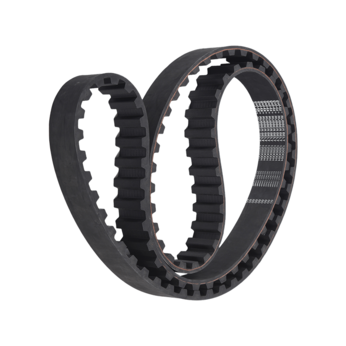What are the effects of poor pulley alignment on Raw-Edge V-Belts
Reduced Transmission Efficiency
Raw-Edge V-belts are designed to maintain precise alignment between the belt and pulleys to ensure stable friction transmission. When the pulleys are misaligned, the belt will slip and deflect laterally during operation, reducing the contact angle and the friction coefficient, resulting in a decrease in effective transmission force. This reduces transmission efficiency, resulting in insufficient equipment output power, increased motor load, and significantly higher energy consumption. Over time, this efficiency loss leads to a decrease in overall production line energy efficiency and increased equipment operating costs.
Increased Belt Wear
Pulley misalignment causes uneven force distribution on Raw-Edge V-belts, placing additional frictional stress on the belt edges. This localized stress concentration leads to premature wear on the belt surface, significantly increasing edge debonding, cracking, or fiber breakage. Wear not only shortens belt life but can also cause belt deviation or breakage. Because Raw-Edge belts have unwrapped edges, they are more sensitive to alignment accuracy. Once misalignment exceeds the tolerance range, wear accelerates significantly.
Increased Operating Temperature
Pulley misalignment creates additional friction and lateral strain on the belt during transmission, increasing operating resistance. Increased friction raises the belt surface temperature, causing the rubber material to age, harden, or deform under high temperatures. Excessive temperatures can also cause fatigue failure in the belt's internal fiber layer, compromising overall structural stability. This operating temperature increase not only affects transmission efficiency but can also increase the equipment's heat dissipation burden, increase motor temperatures, and reduce system reliability.
Abnormal Vibration and Increased Noise
Poor pulley alignment can cause the belt's force direction to shift, resulting in periodic jitter and jerkiness during operation. The vibration frequency is related to the belt speed, increasing with increasing speed. Vibration generates noticeable mechanical noise, impacting the equipment's operating environment and operator comfort. Vibration also places additional impact loads on bearings, tensioners, and motor shafts, increasing the risk of mechanical fatigue. Over long-term operation, equipment stability decreases, requiring increased maintenance.
Risk of Belt Tracking and Derailment
Raw-Edge V-belts must maintain a stable center trajectory at high speeds. If the pulleys are not properly aligned, the belt can easily shift toward the side with less tension, gradually moving out of the center of the belt groove. Even slight misalignment can cause the belt edge to rub against the metal rim. In severe cases, it can cause the belt to derail from the pulley. Derailment not only causes a momentary transmission failure but can also pose a safety hazard, resulting in equipment downtime or damage. Maintaining strict pulley alignment is crucial to preventing misalignment.
Significantly Reduced Belt Life
Poor alignment directly affects belt force distribution, causing the belt to experience asymmetrical tension for extended periods. Unbalanced stress between the tension layer and the cover layer within the belt can lead to separation, breakage, or fatigue. The service life of a Raw-Edge V-belt typically relies on balanced tension. Persistent pulley misalignment can shorten its life by 30% to 50%. Frequent belt replacement not only increases maintenance costs but also impacts production continuity and equipment reliability.
Damage to Equipment Components
Poor pulley alignment not only affects the belt itself but also poses potential damage to other components in the drive system. Uneven loads can lead to uneven bearing force, causing abnormal wear or overheating. Lateral forces acting on the motor shaft and driven pulley bearings can cause bending stresses, shortening the service life of mechanical components. Frequent belt tensioning adjustments due to belt deflection increase wear and tear. This gradually reduces the overall system's mechanical accuracy, impacting equipment reliability and productivity over the long term.
Increased energy consumption and costs
Pulley misalignment reduces system transmission efficiency, requiring the motor to deliver higher power to maintain the same output power. Increased energy consumption leads to higher operating costs. Frequent belt and component replacement increases maintenance expenses, further increasing production losses caused by equipment downtime. The economic impact of poor pulley alignment is particularly significant in continuous production industries such as textiles, manufacturing, and conveying equipment. Maintaining accurate drive system alignment can significantly reduce energy consumption and operating costs.
Hot Products
-
 View More
View More
-
 View More
View More
V-belt For Industry
-
 View More
View More
T Type Industry Rubber Synchronous Belt
-
 View More
View More
Toothed wedge belt
-
 View More
View More
Thickened timing belt
-
 View More
View More
Open Timing Belt
-
 View More
View More
Automotive V-belt
-
 View More
View More
Rubber Flat Belt
-
 View More
View More
Ribbed Belt
-
 View More
View More
Synchronous Pulley
-
 View More
View More
Arc tooth industrial rubber synchronous belt
-
 View More
View More
Automotive timing belt

 English
English 简体中文
简体中文
